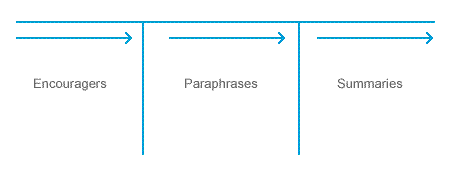Encouragers, Paraphrasing and Summarising
A counsellor can encourage a client to continue to talk, open up more freely and explore issues in greater depth by providing accurate responses through encouraging, paraphrasing and summarising. Responding in this way informs the client that the counsellor has accurately heard what they have been saying. Encouragers, paraphrases and summaries are basic to helping a client feel understood.
Encouragers, also known as intentional listening, involve fully attending to the client, thus allowing them to explore their feelings and thoughts more completely. Paraphrasing and summarising are more active ways of communicating to the client that they have been listened to. Summarising is particularly useful to help clients organise their thinking.
The diagram below shows how encouragers, paraphrases and summaries are on different points of a continuum, each building on more of the information provided by the client to accurately assess issues and events.
Encouragers – Encouragers are a variety of verbal and non-verbal ways of prompting clients to continue talking.
Types of encouragers include:
- Non-verbal minimal responses such as a nod of the head or positive facial expressions
- Verbal minimal responses such as “Uh-huh” and “I hear what you’re saying”
- Brief invitations to continue such as “Tell me more”
Encouragers simply encourage the client to keep talking. For a counsellor to have more influence on the direction of client progress they would need to make use of other techniques.
Paraphrases – To paraphrase, the counsellor chooses the most important details of what the client has just said and reflects them back to the client. Paraphrases can be just a few words or one or two brief sentences.
Paraphrasing is not a matter of simply repeating or parroting what the client has stated. Rather it is capturing the essence of what the client is saying, through rephrasing. When the counsellor has captured what the client is saying, often the client will say, “That’s right” or offer some other form of confirmation.
Example: I have just broken up with Jason. The way he was treating me was just too much to bear. Every time I tried to touch on the subject with him he would just clam up. I feel so much better now.
Paraphrase: You feel much better after breaking up with Jason.
Summaries – Summaries are brief statements of longer excerpts from the counselling session. In summarising, the counsellor attends to verbal and non-verbal comments from the client over a period of time, and then pulls together key parts of the extended communication, restating them for the client as accurately as possible.
A check-out, phrased at the end of the summary, is an important component of the statement, enabling a check of the accuracy of the counsellor’s response. Summaries are similar to paraphrasing, except they are used less frequently and encompass more information.



Yeah,must say i like the simple way these basic counselling skills are explained in this article. More of same would be most welcome as it helps give a better understanding of the counselling process and the methods and techniques used within the counselling arena
I really find this information helpful as a refresher in my studies and work. Please keep up the excellent work of ‘educating’ us on being a better counsellor. Thank you!
Wonderfully helpful posting. Many thanks!
Thankyou so much. I am doing a assignment at uni about scitzophrenia and needed to clarify what paraphrasing truly meant. Cheers
So helpful to me as a counselor.
thanks
Thankx so much for these post. I’m doing Counselling and Community Services and I need to clarify what summarising and paraphrasing really meant. Once again thank you, this information it’s really helpful
Hello Antoinette friend and doing guidance and counselling need uo help about this question
With relevent examples explain the following concepts as used in communicating to clients.
(I;listening to verbal messages and using encouraged minimal prompts.
2)making use of non verbal communication and exhibiting attending behaviours using Gerald Eganis macro skill SOLER/ROLES.
3.paraphrasing
4.identifying and reflecting feelings and emotions from the clients story
5.summarizing
6.confrotation
7.counsellor self disclosure
8.asking open and close open ended concept
9.answering questions
10.clarifying
thanks I am doing a counselling community services at careers Australia
Really love the explanations given to the active listening techniques it was really useful and helpful good work done.
Helpful. Thanks!
I really like hw u explain everything in to simple terms for my understanding.
Hai ,thanks for being here .Am a student social worker,i need help an an able to listen to get the implied massages from the client.and to bring questions to explore with them .I love to do this work .What shall I do.how do i train my self in listening.
really appreciate.
You explanation of these three basic intentional listening are very helpful. Thank you for remained us.
very helpful indeed in making the client more open and exploring the issues more deeply
Very important cues.thanks
the article was helpful .thank you for explaining it in more clear and simple words.appreciate it alot .
I need to write about what counselling words mean ie I understand summarising and paraphrasing any more would be useful as I’m near the end of my course
I have a role play exam tomorrow on counselling and find above explanation very useful. thanks for sharing.
This explanation is clear and precise. Very easy to understanding than the expensive textbook. Please keep posting as this helps a lot. Thanks and God bless.
Pingback: Summarising In Counseling (a Comprehensive Overview) | OptimistMinds
One of the simple and memorable descriptions of this I’ve read, thanks so much!